#Traditional Indian clothing for special occasions
Explore tagged Tumblr posts
Text
Ethnic Warehouse - Shop Now for Ethnic Warehouse's Chikankari Saree

Discover the authentic essence of Bengal through a wide selection of sarees for women in West Bengal, exclusively at Ethnic Warehouse. Our collection embodies the cultural richness of the region, featuring traditional weaves and designs. Embrace the grace and elegance of these sarees, perfect for every occasion. Elevate your style with the timeless beauty of Bengal sarees, exclusively available at Ethnic Warehouse, where tradition and fashion unite seamlessly.
#Shop now for Ethnic Warehouse's Chikankari saree#Soft and lightweight fabric for comfortable wear#Hakoba detailing on traditional ethnic saree#Intricate chikankari embroidery and mirror work saree#Exquisite yellow and red Chikankari saree#Traditional Indian clothing for special occasions#Buy Chikankari saree with Hakoba body online
0 notes
Text
#nice soft material#arrived on time#Thanks for the kind words! ★★★★★ parbattie https://etsy.me/4h24Yah#etsy#white#formalevent#dress#organiccotton#yellow#dressforkids#newborndress#giftforbaby#kidsdhotikurta
3 notes
·
View notes
Video
tumblr
Cultural Traditions at Princess Iman bint Abdullah’s Henna Party, 7 March 2023
The henna party is the Arab version of the West’s bachelorette party. “Henna usually takes place one to two weeks before the wedding night,” (x)
“Henna was largely used in ancient Egypt and India as a form of temporary tattoo for religious ceremonies, wedding festivals and for simple body decoration and even to dye hair. Brides usually have their hands and feet decorated as part of wedding rituals.” (x)
Henna styles differs across regions. “With time, henna application has become an art form, and today, brides book professional mehandi artists keeping their aesthetic sensibilities in mind. Generally, Arabic (Middle-Eastern) mehandi features large, floral patterns on hands and feet (but only till the wrists and the ankles), while Indian (Asian) mehandi is characterised by fine lines, lacy, floral and paisley patterns covering hands, forearms, feet and legs. And African mehandi is usually large and bold with geometrically patterned angles, often created using black mehandi.” (x)
Fragrance: In the video, guests were seen scented with bakhoor (wood chips that are soaked in fragrant Oud oils). It is used during special occasions such as weddings, or simply for relaxing purposes. In Arabian culture, it’s a traditional gesture to pass bakhoor among guests, so they can scent their hair, clothing and hands. This is believed to be a as integral to hospitality as serving coffee and dates. (x)
#Jordan#jordanian royal family#princess iman#Wedding#video#Princess Sara bint al Faisal#Princess Aisha bint Al Faisal#Queen Rania
117 notes
·
View notes
Text
Why Punjabi Juttis Are the Ultimate Valentine’s Day Footwear Choice
Valentine's Day is about love, romance, and sharing time with those special people in your life. While everyone tends to worry about their clothes, the right shoes can make all the difference in how you look and feel. If you want to dress up your Valentine's Day look, nothing beats the classic elegance of a pair of Punjabi juttis. These heritage shoes, famous for their distinctive style and cultural heritage, provide comfort and glamour, making them the ideal shoe for this occasion.

In this article, we will discover why Punjabi juttis are the go-to Valentine's Day footwear option, how you can pair them with any kind of clothing, and why they should be on your shopping list. If you're having a romantic dinner or an everyday date, Punjabi juttis will be that ideal combination of classiness and tradition that completes your outfit.
What Are Punjabi Juttis?
Punjabi juttis are a classic style of shoe that hail from the Punjab region, which stretches across India and Pakistan. Punjabi juttis are reputed for having elaborate hand-embroidered patterns, bright colors, and a characteristic flat design. The juttis themselves are crafted out of leather, cloth, or velvet and come with intricate stitching, mirror work, and beading, and these are notable both as a functional as well as fashionable choice of shoe.
What distinguishes Punjabi juttis from other footwear is the fact that they have no heel and, thus are easy to wear for extended periods. They provide a close fit and are usually available in different colors, designs, and adornments, thus a stylish twist that makes them not only appropriate for casual activities but also for more formal events. These juttis have, over time, adapted to new tastes while maintaining their classic appeal, thus becoming a favorite among people during festive events such as weddings, cultural festivals, and, of course, Valentine's Day.
Why Choose Punjabi Juttis for Valentine’s Day?
Valentine's Day is a day when everyone wishes to feel special, and the right footwear is an important part of that. Here's why Punjabi juttis are the ideal option to top off your Valentine's Day look.
1. A Perfect Blend of Tradition and Modernity
Punjabi juttis elegantly marries traditional skills with modern design inputs. Whether you're dressed in a saree, a salwar kameez, or even a Western garment, these juttis bring with them a distinct cultural flavor that can change your style. Their timelessness renders them versatile enough to go along with trendy fashion without losing their roots. If you are dressing up with a bold, eye-catching look on Valentine's Day, a pair of bright, intricately worked juttis is sure to stand out.
2. Comfortable All-Day Wear
Unlike high heels, which hurt to wear all day, Punjabi juttis are the perfect comfort choice. Their plush leather make and flat bottom design mean you'll be comfortable morning till night, so whether dancing the night away at a Valentine's Day function or taking an evening stroll to dinner, you can keep on your juttis all day without a moment's discomfort. You don't have to compromise style for comfort, and that is exactly what you get from Punjabi juttis - pure comfort mixed with pure style.
3. A Wide Variety of Designs
Punjabi juttis have an array of designs, so that you can select the most suitable one that suits your style as well as Valentine's Day dress. Right from traditional metallic colors to vibrant and bold colors, there is something for every moment. If you want to go for a sophisticated look with a subtle touch, a plain designer Punjabi jutti can provide sophistication as well as elegance. Want to stand out? Go for the juttis with elaborate beadwork, sequins, or embroidery providing a spark of glamour to your entire look.
4. Versatility for Any Outfit
One of the main reasons Punjabi juttis are perfect for Valentine's Day is its versatility. The juttis can complement traditional Indian outfits like lehengas, anarkalis, or sarees as well as dresses or skirts or pants. For an evening intimate setting, they can be paired with a flowing gown or a classically designed blouse with jeans - a stylish, yet traditional take. Whether you want boho or just an elegant affair, Punjabi juttis are versatile enough to be styled according to your fashion choices.
5. A Unique Gift Idea
If you are not planning to buy them for yourself, then gift a pair of Punjabi juttis to your loved one on Valentine's Day. Their intricate designs and handcrafted nature make them a thoughtful and meaningful gift. A pair of well-chosen juttis is not just a piece of footwear but a statement of love and appreciation. Plus, the uniqueness and cultural significance of the juttis will remind them of the special day whenever they wear them. Read the article to know more about choosing the best punjabi juttis.
6. Perfect for Every Valentine’s Day Setting
Valentine's Day is very different regarding the way people may celebrate it. Be it a quiet dinner for two, or a romantic dance, or simply a casual outing, Punjabi juttis would suit any ambiance. The beauty of the design suits them to formal situations, while comfort and ease with design make them good for casual outings as well. This makes it all-in-one footwear for every celebration.
7. Sustainable and Ethically Made
Many modern designers who create Punjabi juttis focus on sustainable and ethical production methods. Sustainable fashion is getting more attention lately, and with that, such shoes are created using eco-friendly materials like vegan leather or fabric sourced locally. When you purchase a pair of juttis, you're not just supporting traditional craftsmanship but also contributing to the preservation of culture and the environment. Choosing ethical and handmade products gives your Valentine's Day a little extra meaning, knowing that your footwear is supporting a cause you can feel good about.
How to Style Punjabi Juttis for Valentine’s Day
Styling your Punjabi juttis for Valentine’s Day is all about balancing comfort and glamour. Here are some tips to help you put together the perfect look:
Pair with a Long Dress or Gown: For an elegant and flowing look, match your Punjabi juttis with a maxi dress or gown. The intricate patterns and bright colors of the juttis will complement the flow of the fabric and create a stunning visual effect.
Traditional Outfits: If you're wearing a saree or lehenga, Punjabi juttis are the perfect complement. The rich embroidery and designs can add a fresh and modern touch to traditional attire.
With Casual Wear: Punjabi juttis also work well with casual outfits like a long tunic, kurti, or even a pair of jeans. Keep the look relaxed yet fashionable with simple designs, and add accessories like a statement necklace or earrings to complete the outfit.
For Date Night: If you're keeping it simple yet elegant, pair a Punjabi jutti for women with a sleek outfit like a chic jumpsuit, tailored pants, or a little black dress. A metallic or embellished pair will add the right amount of glam to your ensemble.
Why You Should Choose Mystic Sole for Your Punjabi Juttis
The right brand is what matters in finding the ideal pair of Punjabi juttis for Valentine's Day. Mystic Sole offers a large variety of handcrafted juttis that marry traditional craftsmanship with contemporary styles. Whether you need a simple designer Punjabi jutti that matches a minimalistic outfit or something more elaborate for a bolder look, Mystic Sole has something to suit every taste.
Mystic Sole ensures to pay all attention to detail, great material, and comfort. Every single pair of juttis has been designed very carefully to have the perfect fit and long-term wear so you can feel sure and stylish the whole day through. Moreover, through online shopping, you could even Buy Punjabi Jutti Online from your home, sitting on your comfortable couch, using quick delivery systems so that they can reach in time for the day of Valentine.
At Mystic Sole, customer satisfaction is of great importance, and they are dedicated to helping you find the best footwear according to your needs. Whether you shop for yourself or a loved one, Mystic Sole is sure to guarantee that you get the perfect juttis in terms of aesthetics and comfort.
Conclusion
The ultimate Valentine's Day shoe would be Punjabi juttis, as they combine tradition, comfort, and style. These are very versatile, unique designs with timeless appeal, which makes them match any kind of outfit for an even more special Valentine's Day celebration. If you're going to create a statement or just stick to casual all-day comfort, Punjabi juttis are a perfect fit. So, why not buy yourself or someone you love such a beautiful iconic pair of shoes this Valentine's Day?
When you finally decide to seek the perfect fit, look for no other store than Mystic Sole, where quality meets traditions in every step.
#Buy Punjabi Jutti Online#Simple Designer Punjabi Jutti#Punjabi Jutti For Women#Valentine’s Day Footwear Choice#Valentine's Day#Punjabi juttis#mysticsole#gift for her#choosing the best punjabi juttis
2 notes
·
View notes
Text
Today, we’re veering off the beaten path to spotlight a commendable endeavor by a client we’re proud to associate with.
Today, we embark on an exciting departure from the usual and turn our spotlight onto a remarkable project undertaken by one of our esteemed clients, an association we take immense pride in.
The arrival of a newborn is a moment of pure joy, filling the hearts of all involved with an undeniable charm and a deep desire to commemorate the occasion with a special gift. While the conventional choice of traditional baby attire is undeniably sweet and endearing, it often represents the well-trodden path when it comes to gifting. But for those who seek to infuse a touch of unexpected delight into their gestures, we invite you to join us on an exploratory journey through the lesser-known realms of baby gifting in the enchanting landscapes of Malaysia.
Here, amidst the vibrant tapestry of cultures and traditions that weave together, we’ll uncover a world of creative and thoughtful options that extend beyond the ordinary. From exquisitely handcrafted baby clothing that pays homage to the rich heritage of the region to innovative and eco-conscious baby products that resonate with the spirit of the modern world, the possibilities are boundless. So, if you’re in the mood for something refreshingly unique and are ready to veer off the beaten path, let’s embark on this adventure together and redefine the art of newborn baby gift sets in Malaysia.
Malaysia: A Legacy of Meaningful Gifting
Malaysia boasts a vibrant cultural mosaic, reflected beautifully in its gift-giving customs. Here, presenting gifts transcends routine—it’s a heartfelt expression, deeply woven into the fabric of their customs and a symbol of deep respect.
Interlacing the threads of Malay, Chinese, and Indian influences creates an expansive gifting palette that seamlessly marries tradition with modernity. Whether it’s festive periods, birthdays, or other significant events, the people of Malaysia prefer gifts that echo the receiver’s emotions.
Welcoming New Life with Open Arms in Malaysia
In the realm of new beginnings, the cultural tapestry of Malaysia comes alive with the celebration of new life. Each community, with its distinctive rituals, takes center stage. The Malay community, for example, has unique celebratory practices and blessings deeply rooted in their faiths. What’s common across these traditions is the sheer joy expressed through gifting, with offerings ranging from elaborate jewelry to bespoke baby garments, each imbued with hopes for the infant’s future.
A Blend of Time-Honored and Contemporary
While Malaysia holds dear to its established infant traditions, it’s not untouched by modern global influences and societal changes. Parents often combine old customs with new trends. Baby showers, originally a Western concept, have gained traction, blending festivity with anticipation.
The gifting of keepsakes, such as the infant’s first hair lock or footprint impressions, has also become popular, highlighting the evolving culture of Malaysia, which respects its heritage while welcoming new practices.
Blissbies: A New Epoch of Baby Gift Sets in Malaysia
Say goodbye to the conventional stuffed toys and bodysuits; Blissbies Malaysia is transforming baby gift sets in Malaysia. Their expertly chosen baby gift sets marry enjoyment with learning, and they come with a seal of approval from the toughest judges—babies themselves!
The experience is elevated by the presentation—the artisanal kraft boxes that not only carry gifts but become a part of the celebration.
Awaiting inside? Ingeniously designed playthings to enthrall young, curious minds.
Blissbies’ Essence: Beyond the Tangible
Blissbies’ vision extends past the physical products. They champion gifts with significance, items that become companions on the wondrous journey of parenthood, aiming to create unforgettable moments with offerings that spark imagination and wonder.
Their selection, from intricately embroidered towels to personalized wooden name plaques, weaves individual tales. This, combined with their organic apparel, orchestrates a symphony of style and coziness, suitable for both girls and boys, ensuring a touch of uniqueness and joy.
The Signature Blissbies Unveiling Experience
Every Blissbies signature purple box is an odyssey of discovery. Each package is an embodiment of pure love, meticulous attention to detail, and master craftsmanship. And the surprise sachet inside? It’s the perfect finishing touch!
Elevating Gifting with Blissbies
Every package from Blissbies is a lesson in refined gifting. Presented in their iconic purple boxes, these gifts set the benchmark in the baby gifting sector of Malaysia.
The box alone makes a statement, and with the addition of the sachet, it places Blissbies at the pinnacle of baby gifting elegance.
Crafting Personalized Heirlooms
With Blissbies, generic is not an option. Explore their wide assortment and select from essentials and treasured keepsakes to create a gift that exudes warmth, innovation, and heartfelt sentiment.
Conceived for the Little Trailblazers
Blissbies curates for tomorrow’s trailblazers, catering to children from birth to two years. With an eye on inclusivity and safety, their collection promises a balance of secure and joyful products.
Blissbies: Smooth Sailing from Selection to Delivery
Navigating Blissbies’ offerings is effortless. They offer various payment methods, ensuring ease of use.
Their commitment to customer contentment doesn’t end with the purchase. They stand by their service, offering prompt assistance and resolution to any concerns, just an email away.
Fostering Development Through Purposeful Play
In the formative years, play is a significant avenue for development. Blissbies understands that toys are key in fostering cognitive, sensory, and physical growth. Their handpicked selection ensures playtime is enriching and constructive, supporting the foundation for rounded development.
Synergy of Elegance and Practicality
For Blissbies, aesthetic appeal is not an afterthought, even for the smallest of clients. Their offerings dazzle with colors, textures, and patterns, enhancing a child’s sensory journey. But their commitment extends beyond appearances, with every design stirring emotions and crafting engaging stories.
Blending contemporary design with timeless craftsmanship, Blissbies’ products embody the perfect union of beauty and utility.
Beyond a Brand, A Community
Blissbies is more than a brand—it’s a collective, nurturing a space for parents to share stories and experiences. Their engaging blog and social media channels are a treasure trove of parenting wisdom and shared experiences from their expanding community.
2 notes
·
View notes
Text
Flag of the Cherokee Confederacy

This is the flag of the Cherokee Confederacy. It comes from a world where the Spanish Armada successfully conquered England in 1588. While England did eventually regain its independence, the Spanish conquest severely stunted England’s growth as a world power, and lead to greater political instability. As a result, England never became a demographic juggernaut during the colonization of North America. The lands that would have become the Thirteen Colonies are a patchwork of nations and colonies founded by numerous European nations. There are also several independent indigenous nations, such as the Cherokee Confederacy.
The Cherokee Confederacy also includes the Muskogee, Chickasaw, and Choctaw tribes. The Cherokee, as reflected by the name, were the founding tribe of the confederacy. The Cherokee Confederacy was one of the first indigenous nations of North America to implement westernization and industrialization programs. Today, most Cherokee dress in European-style clothing, but do wear traditional clothing on special occasions. Like most southern nations in eastern North America, the Cherokee historically practiced slavery. Slavery was formally abolished in 1885 as part of the modernization efforts. Racial divides and tensions still remain, but the Cherokee government has, in recent years, implement programs to help blacks integrate into Cherokee society.
The Cherokee legislature, known as the Tribal Council, is organized into a semi-parliamentary democracy, with a prime minister as the Head of Government, and a president as Head of State. The Cherokee Tribal Council is closer in style to the French National Assmbly, rather than to the English Parliament. The Cherokee Confederacy is centered around what would be western North Carolina, Tennessee, and the northern bits of Alabama, Mississippi, and Georgia. The indigenous republics of North America, being sovereign nations, did not suffer an equivalent of the Indian Removal Act.
Historically, the Cherokee Confederacy has been rivals with the Haudenosaunee Federation. However, in recent times the two nations have been putting their rivalries behind them. In terms of good relations, the Cherokee Confederacy has historically been an ally of New Neatherlands, which in located in Virginia. The various nations of North America have formed a European Union-style economic union, and there are hopes that this will eventually leads to a federation. There is a general spirit of good will and optimism. That said, North America still has a ways to go before its nation states become united.
The flag contains seven gold stars in the shape of the Big Dipper, or Ursa Major, on an orange field with a green border. Ursa Major is an important constellation to several tribes within the Cherokee Confederacy. It also symbolizes how the same night sky shine over the entire Cherokee Confederacy. Blue would seem a natural color choice, but the Cherokee picked orange instead. There is some debate about why this is. Popular belief says that it symbolizes the Cherokee Confederacy’s ties to New Netherlands. However, the Cherokee actually picked orange to contrast with the blue flags several other North American nations use. The green border is to offset the orange.
Link to the original flag on my blog: https://drakoniandgriffalco.blogspot.com/2022/05/flag-of-cherokee-confederacy.html?m=1
#alternate history#alternate history flag#alternate history flags#flag#flags#vexillology#Cherokee#Cherokee Confederacy#Creek#muskogee#chickasaw#Five Civilized Tribes#Choctaw#indigenous people#Native Americans#Native American#indigenous#north america#United States#America#USA#United States of America#alt history
37 notes
·
View notes
Text
Rhythms of Mithila: The Spirit of Madhubani Art
Madhubani art, also known as Mithila painting, is one of the most celebrated forms of traditional Indian folk art. Originating from the Mithila region, which spans parts of Bihar, India, and Nepal, this art form is renowned for its unique style, intricate detailing, and vibrant use of colors. The name "Madhubani" translates to "forest of honey," which reflects the rich cultural and natural environment that inspires these artworks.
Historical Background
The origins of Madhubani art are deeply rooted in Indian mythology and history. It is believed that this art form dates to the time of the Ramayana, an ancient Indian epic. According to legend, King Janak of Mithila commissioned artists to create paintings on his daughter Sita's wedding to Lord Rama. This royal patronage helped establish the tradition of creating auspicious images to mark special occasions, a practice that continues to this day.
Traditionally, Madhubani paintings were made on the walls of homes during festivals, rituals, and important life events such as weddings and births. These paintings served as an expression of devotion, a means of preserving cultural narratives, and a way of bringing good fortune. Over time, the medium expanded from walls to cloth, paper, and canvas, making the art more accessible and portable.
Techniques and Materials*
Tools and Materials:
Madhubani art is characterized by its use of simple tools and natural materials. Artists traditionally use fingers, twigs, brushes, matchsticks, and even nib pens to create intricate designs. The natural pigments and dyes used in these paintings are derived from a variety of sources. For instance, yellow is obtained from turmeric, blue from indigo, red from the Kusum flower or red sandalwood, green from leaves, and black from burnt rice. Cow dung and mud are often mixed to prepare the base of the wall paintings, providing a natural texture and background.
Techniques:
The technique involves outlining the designs with bold lines using a mixture of cow dung and mud or black from burnt rice husk. This is followed by filling the spaces with bright, vibrant colors. The paintings often feature a double line border filled with intricate patterns and motifs such as flowers, animals, and geometric shapes. The figures in the paintings are typically depicted in profile, and the faces are drawn with elongated eyes, which is a distinctive feature of this art form.
Madhubani art does not leave any empty space in the composition; every inch is filled with intricate patterns and symbols. This technique of filling the entire space is known as Kachani or Bharni.The detailing and the use of geometric patterns are not just aesthetic choices but also hold cultural and symbolic meanings, reflecting the artists' connection to their cultural heritage.
Styles of Madhubani Art
Madhubani art is not monolithic; it encompasses several distinct styles, each with its own characteristics and thematic focus. The primary styles include:
Kachani Style:
Kachani style of Madhubani painting is style which comes from the Kayastha community by its intricate line work and fine detailing. Kachani is primarily monochromatic, using a minimal palette with black and white being predominant. This style focuses more on the detailing of the figures and the use of fine lines to create patterns. It often represents scenes from nature and daily life.

2. Bharni Style:
The Bharni style is known for its bold, vibrant use of colors and the depiction of mythological figures, nature, and animals. Traditionally practiced by Brahmin women, this style often portrays Hindu deities like Krishna, Rama, Durga, and Saraswati. The emphasis is on filling the central subject with solid colors, while the background may be decorated with intricate patterns.

3. Tantrik Style:
The Tantrik style is heavily influenced by tantric symbolism and motifs. It involves the depiction of tantric deities and yantras (geometric diagrams used in worship). This style is spiritual and esoteric, often featuring complex and abstract patterns that are rich in symbolic meaning.

4. Godna Style:
The Godna style is inspired by traditional tattoo patterns. This style incorporates symbols and motifs that are culturally significant and often linked to social beliefs and practices. It is characterized using repetitive patterns and motifs such as flowers, animals, and geometric shapes.

5. Kohbar Style:
The Kohbar style is specifically associated with marriage rituals. These paintings are created on the walls of the nuptial chamber and depict themes related to love, fertility, and prosperity. The central motif often includes a lotus flower, symbolic of fertility, surrounded by fish, birds, and other auspicious symbols.

Themes and Motifs
Madhubani paintings are rich in symbolism and cultural narratives. The themes can vary widely, but they often revolve around mythology, nature, and everyday life. Common motifs include:
- Mythological Figures: Depictions of Hindu gods and goddesses, such as Lord Krishna with Radha, Lord Rama with Sita, and various forms of the goddess Durga, are prevalent. These figures are often portrayed in vibrant, dynamic compositions that narrate stories from Indian epics and scriptures.
- Nature and Animals: The natural world is a significant inspiration in Madhubani art. Trees, flowers, birds, and animals like elephants, peacocks, and fish are commonly featured. These elements are not just enhancing but are also infused with cultural and spiritual symbolism. For example, the fish symbolizes fertility and prosperity, while the peacock represents beauty and love.
- Social and Cultural Practices: Madhubani art also captures scenes from daily life, such as agricultural activities, festivals, and social gatherings. These depictions provide a glimpse into the cultural practices and traditions of the Mithila region.
- Abstract and Symbolic Patterns: Geometric patterns, tantric symbols, and abstract designs are also a part of Madhubani art. These elements often carry deeper meanings and are used to convey philosophical and spiritual concepts.
Cultural Significance
Madhubani art is not just an artistic expression; it is a vital part of the cultural and social fabric of the Mithila region. The art form is deeply intertwined with the community's rituals, festivals, and social practices. For instance, the Kohbar paintings are an integral part of wedding ceremonies, symbolizing blessings for a happy and prosperous married life. Similarly, paintings of deities are created during festivals to invoke divine blessings.
The art form also serves as a medium for preserving and transmitting cultural knowledge and values. Through the depictions of mythological stories and traditional practices, Madhubani art helps keep the cultural heritage of the Mithila region alive.
Modern Adaptations and Global Recognition
In recent years, Madhubani art has acquired global appreciation and gratitude. The art form has transcended its traditional boundaries and found new expressions in contemporary contexts. Artists are now creating Madhubani-inspired designs on textiles, pottery, home decor items, and even fashion accessories. The use of modern materials and techniques has also expanded the scope of this art form.
The Indian government and various non-governmental organizations have played a crucial role in promoting Madhubani art. Initiatives such as exhibitions, workshops, and cultural exchange programs have helped bring Madhubani artists into the limelight. Additionally, the art form has found a place in international art markets, with collectors and art enthusiasts from around the world appreciating its unique aesthetic and cultural depth.
Economic and Social Impact
The commercialization of Madhubani art has provided a significant source of income for the artists, many of whom are women from rural backgrounds. This economic empowerment has had a positive impact on the community, enabling better access to education, healthcare, and other resources. Moreover, the recognition of Madhubani art on global platforms has instilled a sense of pride and cultural identity among the artists and their communities.
Challenges and Preservation Efforts
Despite its popularity, Madhubani art faces challenges, including the risk of losing traditional techniques and motifs to modernization. The younger generation's inclination towards urban life and modern professions has led to a decline in the number of traditional artists. Additionally, the influx of synthetic materials and commercialization has sometimes compromised the authenticity and quality of the artwork.
To address these challenges, several organizations and art enthusiasts are working towards preserving the traditional aspects of Madhubani art. Efforts include documentation of traditional techniques, promotion of natural dyes, and providing training and support to upcoming artists. Educational programs and workshops are also conducted to create awareness and appreciation for this art form among the younger generation.
Conclusion
Madhubani art is a timeless expression of cultural heritage, artistic excellence, and social narratives. It is a testament to the rich cultural tapestry of the Mithila region and an invaluable part of India's artistic legacy. As this art form continues to evolve and adapt to modern times, it retains its essence and continues to inspire and captivate audiences worldwide. The ongoing efforts to preserve and promote Madhubani art ensure that this beautiful tradition will continue to thrive and enrich the cultural landscape for generations to come.
2 notes
·
View notes
Text
Refresh your wardrobe with Heaven clothing store in Trivandrum
Introduction:
As we search in the ever-changing landscape of fashion,it is easy to get lost in the sea of trends and fast-fashion. But at Heaven Clothing Store in Trivandrum,we believe that style and sustainability go hand in hand. Our mission is to provide high-quality,fashionable clothing that not only makes you look and feel great but also supports a more environmentally friendly future. As we support more sustainable future fashion clothing
Indian fashion culture
Indian fashion culture is a vibrant tapestry woven with threads of tradition, innovation, and storytelling. At the heart of Indian fashion lies the timeless art of handloom weaving. Across the length and breadth of the country, skilled artisans ply their craft, creating fabrics that are as rich in history as they are in texture. From the luxurious Banarasi silks to the earthy elegance of Khadi, each handloom creation is a testament to India's artisanal heritage, passed down through generations with love and reverence. We cannot talk about Indian fashion without mentioning legendary sarees. The sari, a beautiful piece of clothing, represents grace, tradition, and feminine charm. It comes in many different styles across India, showing the country's diverse culture. Despite changing fashion trends, the sari remains a timeless symbol.
So Heaven Clothing and the saree boutique in Trivandrum know the importance of sarees. We are passionate about sarees and dedicated to providing our customers with the finest handcrafted designs that celebrate India’s rich textile heritage. We provide a huge collection of traditional and special sarees for our customers.
Indian ethnic wear includes lots of different kinds of clothes that people wear for special occasions or just every day. For example, there's the saree, which is a long piece of cloth that women drape around themselves in different styles. Then there's the salwar kameez, which is like a long shirt paired with loose pants and a scarf. It's comfy and can be fancy too. For big celebrations like weddings, women often wear lehenga cholis, which are fancy skirts with matching tops and scarves. Men have their own traditional outfits too, like the sherwani, which is a fancy coat worn with pants, or the kurta pyjama, which is a long shirt with loose pants. These clothes come in lots of different styles and colors, showing off India's rich cultural diversity.
Indian fashion culture extends far beyond the glitz and glamor of the runway, permeating every aspect of daily life. From the ornate bridal ensembles worn during lavish weddings to the everyday attire of bustling markets and bazaars, fashion is an integral part of Indian society. It's not just about looking good; it's about self-expression, cultural identity, and storytelling through attire. In this way, Indian fashion becomes a language of its own, speaking volumes about tradition, status, and personal style.
In Kerala, people wear a mix of old and new styles. Women often wear traditional Kerala sarees, and men wear Mundus, especially for special events. They look very classy, especially when paired with fancy gold jewelry. But nowadays, Western clothes are also getting popular, especially among young people. Even with these new trends, people still love and value Kerala's cultural traditions. You can see this in the colorful and stylish clothes they wear, which show off both old and new influences. Kerala's fashion is like a mirror, showing its rich history and changing identity.
Heaven clothing store really looking forward to Kerala fashion culture; it becomes heaven as the leading Trivandrum dress shop. We set up a special collection of a mix of traditional wear and western clothing for you. However, as fashion changes, Heaven's clothing also changes.
Traditional wears of India.
India's traditional attire is a vibrant tapestry reflecting the country's diverse cultures, regions, and historical influences. The sari stands as an iconic symbol of Indian femininity, with its graceful draping styles and intricate designs varying from region to region. Meanwhile, the salwar kameez, with its combination of a long tunic, loose trousers, and scarf, holds sway in North India, offering both elegance and comfort. For festive occasions and weddings, the lehenga choli steals the spotlight, blending ornate skirts, fitted blouses, and flowing dupattas into dazzling ensembles, particularly popular in the northern states.
In the world of men's clothing, different outfits have their own special place. The sherwani is the go-to choice for fancy events, with its fancy designs and classic look. On the other hand, the kurta pajama is more relaxed but still stylish, making it good for everyday wear or less formal gatherings. In the southern parts of India, the dhoti is popular. It's simple and traditional, worn by wrapping it around the waist and legs gracefully. In Gujarat and Rajasthan, during celebrations, you'll often see women wearing the colorful ghagra choli. It has vibrant skirts, fancy tops, and flowing scarves, reflecting the festive mood.
India's clothing also varies by region. In Kerala, men wear the mundu. In Kashmir, the pheran is common. And across India, the bandhgala, or Nehru jacket, is loved for its classy look. Each outfit has a story behind it, reflecting the culture and history of its region. Together, they create a rich tapestry of colors, fabrics, and traditions that represent India's diverse people.
Heaven Clothing Store in Trivandrum has special collections of traditional wear, not just Kerala's traditional wear. All over India, traditional wear is in our collection. We also have special wedding collections for the bride and groom. You can select any Indian traditional wear from our store.
Office Outfits.
An office outfit refers to the clothes people wear to work in a professional setting. It typically includes formal or semi-formal attire such as dress shirts, trousers or skirts, blouses, suits, dresses, and appropriate footwear like dress shoes. The specific dress code may vary depending on the workplace culture and industry norms. The aim of an office outfit is to look polished, presentable, and suitable for the work environment while also reflecting personal style within professional boundaries. It's all about looking professional and appropriate for your job. For guys, this usually means shirts, pants, and maybe a tie or a suit. For ladies, it could be a blouse and skirt or pants, a dress, or even a professional-looking top with trousers. The key is to choose clothes that are neat, clean, and not too casual. You want to make a good impression and feel confident while you work.
Women's fashion is currently experiencing a dynamic shift towards sustainability, with a notable emphasis on eco-friendly materials and ethical production practices. This trend reflects a growing awareness of environmental issues and a desire for clothing choices that align with values of responsibility and stewardship. Additionally, the athleisure trend remains popular, seamlessly integrating athletic wear into everyday outfits for a comfortable yet stylish look. Oversized silhouettes are also making a statement, offering a relaxed and effortless aesthetic that prioritizes comfort without sacrificing style. Another emerging trend is romanticized cottagecore fashion, characterized by soft, feminine silhouettes, floral prints, and vintage-inspired pieces that evoke a sense of nostalgia and simplicity. Furthermore, there's a noticeable shift towards gender-neutral fashion, with styles and silhouettes designed to be inclusive and accommodating, shaped by factors such as social media, cultural influences, and sustainability concerns, providing women with a diverse range of options to express their individuality and style preferences. to individuals of all genders.
Men's fashion is currently embracing a blend of classic styles with modern twists, catering to a diverse range of tastes and preferences. Sustainable fashion is gaining traction, with an increasing number of brands offering eco-friendly materials and ethical production practices. Athleisure continues to be a prominent trend, seamlessly blending athletic wear with casual and formal attire for a versatile and comfortable look. Tailoring is also making a comeback, with a focus on well-fitted suits, jackets, and trousers that exude sophistication and style. Additionally, streetwear-inspired looks remain popular, characterized by bold graphics, oversized silhouettes, and urban influences. Men's fashion is evolving to embrace individuality and self-expression, with a focus on quality craftsmanship, versatility, and sustainability.
The "dark side" of fashion refers to the less visible but deeply concerning aspects of the industry, characterized by unethical practices and environmental harm. One prominent issue is the exploitation of workers, particularly in developing countries, where labor regulations are often lax. Garment workers endure long hours, low wages, and unsafe working conditions in factories, contributing to social injustices and human rights violations. Moreover, the fashion industry's rapid production and consumption cycle, known as fast fashion, fuels overproduction, excessive waste, and environmental degradation. Processes like dyeing fabrics and chemical treatments contribute to pollution and resource depletion, further exacerbating the industry's environmental footprint. Additionally, a lack of transparency in supply chains makes it challenging to trace the origins of materials and ensure ethical and sustainable practices throughout production. Addressing these issues requires collective action from industry stakeholders, consumers, and policymakers to promote ethical labor standards, environmental sustainability, and transparency in the fashion supply chain.
.
Solution for this is sustainable fashion Sustainable fashion refers to clothing, accessories, and footwear that are designed, produced, and used in ways that are environmentally friendly and socially responsible. This involves considering the environmental impact of materials and production processes, as well as promoting fair labor practices throughout the supply chain. Sustainable fashion encompasses various practices, including using organic or recycled materials, reducing waste through efficient design and production methods, and supporting ethical labor standards. Additionally, sustainable fashion encourages consumers to make mindful purchasing decisions, such as investing in high-quality, long-lasting pieces and supporting brands that prioritize sustainability. By promoting environmental stewardship and social equity, sustainable fashion aims to create a more ethical and resilient fashion industry.
3 notes
·
View notes
Text
Discovering Style The Top 25 Clothing Brands in India
India's vibrant fashion scene is a reflection of its rich cultural heritage and dynamic contemporary trends. From traditional ethnic wear to cutting-edge street fashion, the Indian clothing market offers a diverse range of options to suit every taste and occasion. In this blog, we'll take a closer look at the top 50 clothing brands in India, known for their quality, innovation, and distinct style.
Fabindia: Celebrating India's traditional crafts and textiles, Fabindia offers a unique blend of ethnic and contemporary clothing.
Biba: Known for its elegant ethnic wear, Biba captures the essence of Indian culture with its vibrant designs and impeccable craftsmanship.
Ritu Kumar: A pioneer in Indian fashion, Ritu Kumar's label epitomizes timeless elegance and luxury.
Anita Dongre: With a focus on sustainable fashion, Anita Dongre's designs exude grace and sophistication.
Sabyasachi: Renowned for his opulent bridal wear and couture collections, Sabyasachi Mukherjee is a name synonymous with luxury and grandeur.
Manish Malhotra: Bollywood's favorite designer, Manish Malhotra's creations blend traditional aesthetics with contemporary glamour.
Tarun Tahiliani: Known for his innovative draping techniques and exquisite craftsmanship, Tarun Tahiliani is a master of fusion fashion.
Masaba Gupta: Bold, quirky, and unconventional, Masaba Gupta's designs reflect her distinctive sense of style and creativity.
Global Desi: Offering a contemporary twist to traditional Indian attire, Global Desi's collections are vibrant, eclectic, and effortlessly chic.
W for Woman: Catering to the modern Indian woman, W for Woman's clothing blends comfort, style, and functionality seamlessly.
For trendy streetwear:
Roadster: A go-to destination for urban fashion, Roadster offers trendy, affordable clothing for men and women.
Voirbelle.in: With a strong presence on Instagram, Voirbelle.in curates the latest streetwear trends from around the world.
Myntra's in-house brands: Myntra's in-house brands like Dressberry, HRX, and Mast & Harbour offer stylish clothing at pocket-friendly prices.
For men's wear:
Manyavar: Specializing in ethnic menswear, Manyavar is a favorite choice for weddings and festive occasions.
Raymond: A trusted name in men's fashion, Raymond offers a wide range of formal and casual attire crafted with precision and finesse.
Peter England: Known for its affordable yet stylish menswear, Peter England is a popular choice among the youth.
Ethnic wear specialists:
Soch: With its exquisite collection of sarees, salwar suits, and lehengas, Soch is a one-stop destination for ethnic wear enthusiasts.
Neerus: Known for its luxurious silk sarees and intricately embroidered outfits, Neerus is a favorite among women of all ages.
For casual wear:
Max Fashion: Offering a wide range of affordable and trendy clothing for men, women, and kids, Max Fashion is a popular choice for everyday wear.
Pantaloons: With its diverse collection of casual wear, Pantaloons caters to the fashion needs of the entire family under one roof.
For fusion wear:
AND: Blending Indian aesthetics with contemporary silhouettes, AND's collections are versatile, modern, and effortlessly stylish.
Ritu Kumar: With her signature blend of traditional craftsmanship and modern design sensibilities, Ritu Kumar's fusion wear exudes elegance and sophistication.
Designer labels:
Shantanu & Nikhil: Known for their avant-garde designs and innovative silhouettes, Shantanu & Nikhil's creations are a favorite among fashion connoisseurs.
Payal Singhal: With her contemporary take on Indian bridal wear, Payal Singhal's designs are a perfect blend of tradition and modernity.
For sustainable fashion:
Anokhi: Committed to promoting traditional Indian crafts and sustainable practices, Anokhi's clothing reflects timeless beauty and eco-consciousness.
Good Earth: Known for its sustainable and ethically sourced clothing, Good Earth's collections celebrate India's rich textile heritage while promoting environmental conservation.
Regional favorites:
Jayalakshmi Silks: A household name in Kerala, Jayalakshmi Silks offers a stunning range of silk sarees and bridal wear that embody the essence of South Indian culture.
Nalli Silk Sarees: With a legacy spanning over eight decades, Nalli Silk Sarees is synonymous with exquisite silk sarees and traditional Indian attire.
Conclusion:
From traditional to contemporary, from haute couture to street style, the Indian clothing landscape is a melting pot of diverse influences and innovative designs. Whether you're looking for timeless elegance, cutting-edge fashion, or sustainable style, these top 50 clothing brands in India have something for everyone. So, embrace your individuality, express your style, and let your wardrobe reflect the vibrant tapestry of Indian fashion.
#clothingbrand#clothingbrands#clothingstore#clothingdesigner#apparelcompany#trendystreetwear#menswear#Ethnicwearspecialists#casualwear#fusionwear#designerlabels#sustainablefashion#regionalfavorites
2 notes
·
View notes
Text
Shop Now for Ethnic Warehouse's Chikankari Saree - Ethnic Warehouse
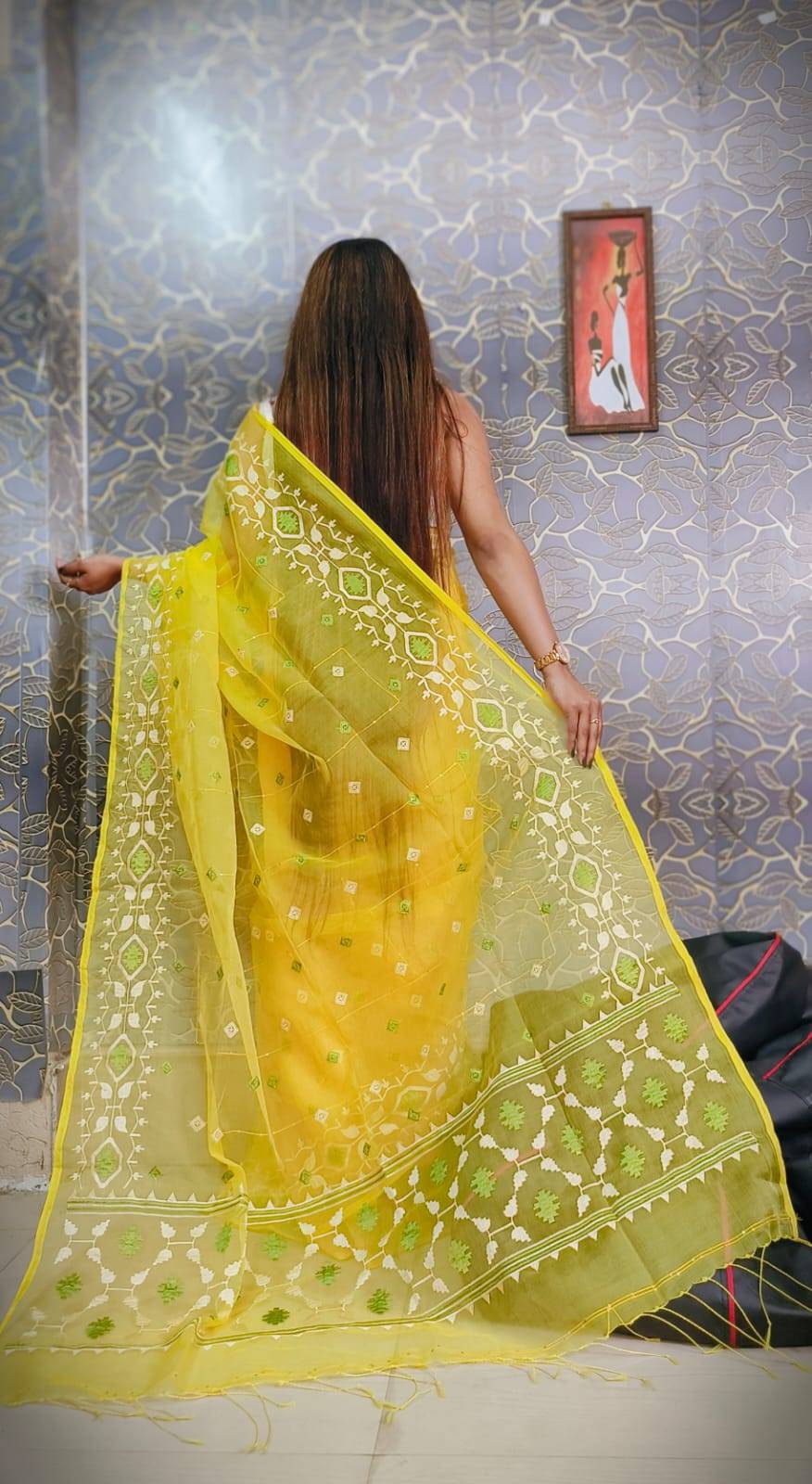
Embrace the artistry of Chikankari Sarees at Ethnic Warehouse. Shop now to discover the elegance of this intricate embroidery technique. Our curated collection embodies the perfect fusion of tradition and contemporary style. Each saree is a testament to India's rich cultural heritage. Experience the timeless beauty of Chikankari sarees, available exclusively at Ethnic Warehouse. Elevate your elegance and celebrate the charm of Indian textiles.
#Shop now for Ethnic Warehouse's Chikankari saree#Elegance and beauty of yellow and red saree#Timeless traditional craftsmanship in Chikankari sarees#Soft and lightweight fabric for comfortable wear#Hakoba detailing on traditional ethnic saree#Intricate chikankari embroidery and mirror work saree#Traditional Indian clothing for special occasions#Buy Chikankari saree with Hakoba body online
1 note
·
View note
Text
Style Haven for Kids: Exploring Christchurch's Premier Clothing Store
Welcome to Christchurch, where fashion meets functionality for the little ones! In this article, we embark on a journey to explore the enchanting world of children's fashion at Style Haven, the city's foremost kids clothing store dedicated to the trendiest and most comfortable outfits for kids. As we delve into the vibrant and playful offerings of this premier establishment, we'll also draw attention to the captivating collection available at Saheli Ethnic Indian Wear, your go-to destination for ethnic Indian children's attire.
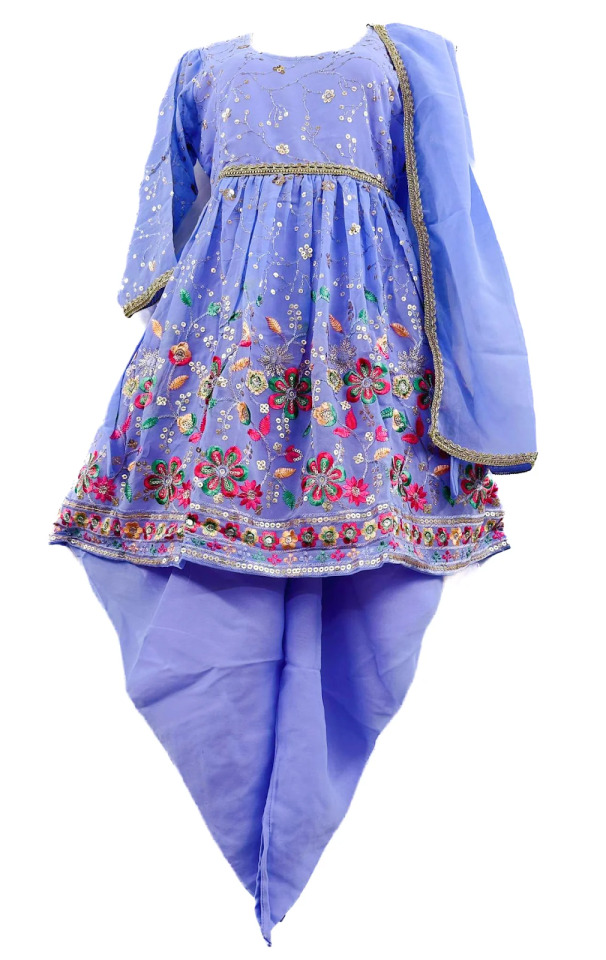
The Allure of Style Haven
A Kaleidoscope of Choices for Every Occasion
Style Haven prides itself on curating a diverse range of clothing options for children of all ages. From casual playdates to formal gatherings, the store offers an extensive selection that caters to every occasion. The racks are adorned with an array of colors, patterns, and styles, ensuring that your little ones are not only fashion-forward but also comfortable in their attire.
Quality Craftsmanship and Durability
One standout feature of Style Haven is its commitment to quality craftsmanship. The garments available are not only stylish but also durable, making them perfect for the active lifestyle of children. Parents can rest assured that their investment in Style Haven's clothing is a wise one, as each piece is designed to withstand the rigors of play and exploration.
Saheli Ethnic Indian Wear: Elevating Traditional Elegance
Infusing Indian Tradition into Children's Fashion
Saheli Ethnic Indian Wear, featured prominently at Style Haven, brings a touch of Indian tradition to the world of kids clothing stores. From vibrant lehengas to adorable kurta-pajamas, the collection showcases a blend of ethnicity and contemporary design. Explore the rich tapestry of Indian textiles and patterns that add a unique charm to your child's wardrobe.
Celebrating Festivals and Special Occasions
For festive occasions and special events, Saheli Ethnic Indian Wear offers a stunning selection of outfits that allow your little ones to embrace their cultural heritage with style. The intricate embroidery, vibrant colors, and luxurious fabrics make these ensembles perfect for celebrations, weddings, and religious ceremonies.
Shopping Experience and Customer Delight
Navigating the Store – A Joyful Experience
Style Haven understands the importance of a seamless shopping experience, especially when it comes to dressing the little ones. The store layout is thoughtfully organized, making it easy for parents and children alike to navigate through the aisles and find the perfect ensemble. Knowledgeable and friendly staff members are always on hand to assist and offer personalized recommendations.
Saheli Ethnic Indian Wear Online – Convenience at Your Fingertips
To enhance convenience, Saheli Ethnic Indian Wear has an online platform, allowing parents to explore and purchase exquisite ethnic wear from the comfort of their homes. The website is user-friendly, with detailed descriptions and sizing guides, ensuring a hassle-free online shopping experience.
Trendsetting Styles and Fashion Tips for Kids
Staying Ahead of the Curve
Style Haven not only offers an extensive range of clothing but also stays on top of the latest fashion trends for kids. The store's keen eye for emerging styles ensures that your little ones are not just well-dressed but also trendsetters in their own right. From adorable prints to fashionable cuts, Style Haven keeps your children's wardrobes current and stylish.
Fashion Tips for Every Season
Navigating the seasonal changes can be a challenge when it comes to children's fashion. Style Haven provides helpful fashion tips for parents, guiding them on the perfect wardrobe choices for different seasons. Whether it's layering up for winter or embracing light fabrics for summer, the store's expertise extends beyond the racks, offering valuable insights for dressing your little fashionistas.
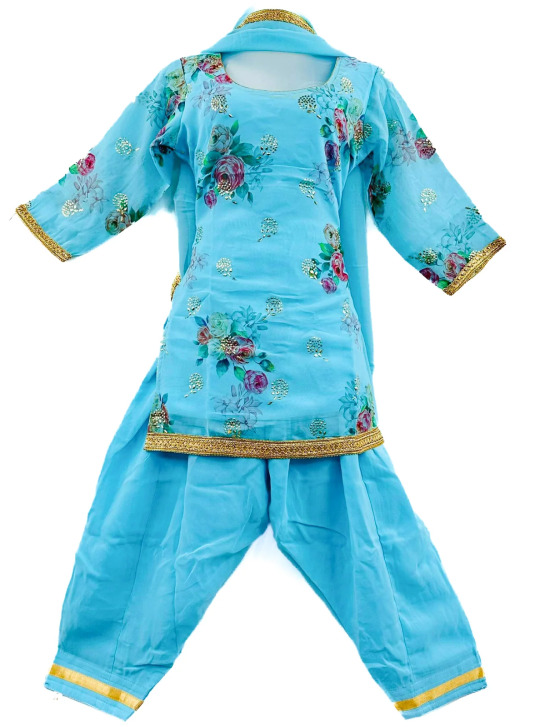
Saheli Ethnic Indian Wear: A Cultural Kaleidoscope
Beyond Fashion – Embracing Cultural Diversity
Saheli Ethnic Indian Wear goes beyond being just a clothing brand; it is a celebration of cultural diversity. The collection not only caters to the Indian diaspora but also invites families from all backgrounds to embrace the beauty of Indian tradition. The store's commitment to inclusivity is reflected in its diverse range of sizes and styles, ensuring every child can experience the joy of ethnic wear.
Customization and Personalization
For those seeking a truly unique touch, Saheli Ethnic Indian Wear offers customization options. From personalized embroidery to bespoke designs, parents can add a special touch to their child's outfit, making it a cherished keepsake for years to come. The store's dedication to individuality sets it apart, allowing families to create memories through the art of clothing.
Community Engagement and Events
Style Haven's Role in Community Building
Style Haven actively engages with the local community by organizing events and activities. From fashion shows featuring the latest kids' trends to charity drives supporting children in need, the store goes beyond being a retail space. By fostering a sense of community, Style Haven establishes itself as more than just a clothing store, becoming a hub for families to connect and share in the joy of parenthood.
Conclusion
In conclusion, Style Haven emerges as a haven for parents seeking both style and comfort for their little ones. The diverse range of clothing options, coupled with the infusion of Saheli Ethnic Indian Wear, elevates the store to a premier destination for kids clothing stores in Christchurch. Whether you're looking for everyday casual wear or traditional Indian attire, Style Haven has proven to be a one-stop-shop for all your children's clothing needs.
Visit the store today and let your child's wardrobe become a testament to style, quality, and cultural richness.
2 notes
·
View notes
Text
Sharara Suit For Women Wedding
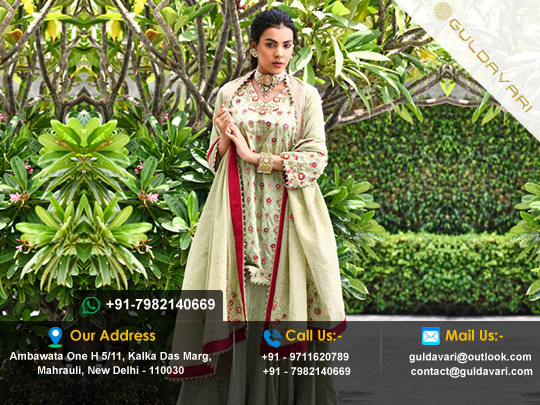
Sharara is another bottom style that is loved by every woman who loves to wear traditional clothing. It is also an essential wardrobe staple for every woman who loves dressings up for special occasions where one can flaunt their pretty traditional attires. But there are so many sharara styles to choose from and here are some of those sharara.
Sharara suits are highly popular among everyone and are the best to style for all functions. From haldi to reception you can rely on a Sharara suit. Some of my best ways to style a Sharara suit are:
1. A Saree-Like Look - Ditch your suit and wear a blouse with sharara
2. Heavy jewelry- You can style your sharara suit and pair it with jewelry for that extra look ( This looks best for a wedding)
3. Pop Makeup & colors - If you have a neutral/light color sharara suit you can try a colorful makeup
4. Cardigans /Jackets- A lot of people have started using Indian cardigans over sharara suits for that extra look
Gathered style– Light fabrics like chiffon and georgette are best to use for this style. If you want a sharara in these fabrics then it's best to go for a gathered style to give this silhouette a much-desired flare at the bottom.
Pleated style– If you have a medium-weight fabric then go for fine knife pleats to give the sharara a voluminous look. Fabric-like fine silk is perfect for this look.
Tiered style– If the simple style doesn’t fascinate you then do try the multi-layered or the tiered sharara style where the sharara is done in layers and is gathered at every layer.
Two-layered sharara– The bottom part of the sharara can also be done in two parts and its best to use eye-catchy embroidery here to make the silhouette look more beautiful.
Multi layered– One can add more layers to this silhouette like in the picture. Needless to say that this style looks beautiful while you walk, and in general too the layers add a modern touch to this traditional bottom style.
Salmon Pink Sharara Suit By Abhinav Mishra!
One designer that we blindly trust with our sharara suits would be Abhinav Mishra. This popular sharara suit made of raw silk has won us over. Hand embroidered with zari, sequins and mirror work is simply so GORGEOUS!
Banana Yellow Sharara With Floral Print
The banana-yellow Kurti in silk with floral print is decorated with thread and sequins embroidery in heritage motifs. The suit is further embellished with zardozi, Kundan and buttons on the placket. This comes with a pleated silk bottom and a net dupatta enhanced with pearls and zari lace.
Latest Sharara Suit in Red and Pink Hues!
Painted in red and pink hues this Sharara suit comes with a lehariya printed Kurti in crepe with Gotta Patti embroidery, French knots and sequins embroidered mesh on the neckline and buttis.
2 notes
·
View notes
Text
Bridal lehengas: The real embellishment for a bride’s big day
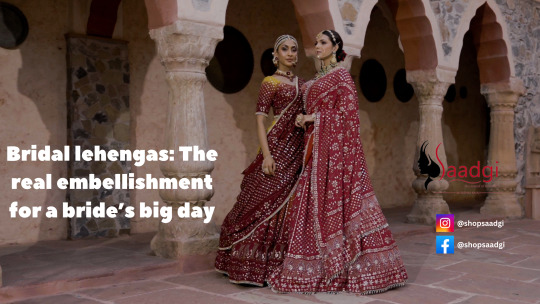
When it comes to a bride's wedding day, one of the most important decisions she has to make is choosing the perfect bridal lehenga. The bridal lehenga is not just a piece of clothing; it is a symbol of tradition, culture, and beauty. Let's explore why the bridal lehenga is considered the real embellishment of a bride.
What is a bridal Lehenga?
A bridal lehenga is a traditional Indian outfit worn by brides on their wedding day. It consists of a long skirt, a blouse, and a dupatta. The lehenga is usually heavily embellished with intricate embroidery, sequins, beads, and more. It comes in various colors, with red being the most popular choice.
Why is a Bridal Lehenga Special?
It holds immense significance in Indian weddings. It is not just a garment; it is a reflection of the bride's personality, style, and cultural heritage. Here are a few reasons why the bridal lehenga
is considered the real embellishment of a bride:
Cultural Significance
The bridal lehenga represents the rich cultural heritage of India. It showcases the traditional craftsmanship and artistry of Indian artisans. Each region in India has its own unique style of embroidery and embellishments, making every bridal lehenga a work of art.
Symbol of Beauty
The lehenga enhances the beauty of a bride and makes her look ethereal on her special day. The intricate embroidery and embellishments add a touch of glamour and elegance to the overall bridal look. It is designed to make the bride feel like a princess.
Traditional Values
Wearing a lehenga is a way for brides to honor and uphold their cultural traditions. It is a symbol of respect for their roots and ancestors. The bridal lehenga is often passed down through generations, making it a cherished family memory.
Emotional Connection
It holds sentimental value for the bride and her family. It is a garment that is carefully chosen and adored for a lifetime. The memories associated with wearing the bridal lehenga on the wedding day create an emotional connection that lasts forever.
Bridal Confidence
Wearing a beautifully crafted lehenga boosts the bride's confidence and makes her feel special. It is a garment that is designed to make her stand out and be the center of attention on her big day. The bridal lehenga empowers the bride and gives her a sense of pride.
Summing up: The lehenga is not just a piece of clothing; it is a symbol of tradition, culture, and beauty. It holds immense significance in Indian weddings and is considered the real embellishment of a bride. Wearing it is not just about looking beautiful; it is about embracing one's cultural heritage and celebrating the occasion of marriage.
#bridal lehenga#lehenga#wedding#embroidery#handcrafted#chikankari#fabric#hand work#fashion#outfit#crafts#stitch#bride#bridesmaids#wedding dress#bridal
2 notes
·
View notes
Note
Happy WBW, lovely! Not sure why, but today I'm asking about fashion?? What does the fashion-- I'm talking high, street, or anything else-- look like in your world(s)?
Happy WBW, Tori!
I answered something similar to this here, but I'll add a little more since I didn't talk about fashion overall.
To summarize, it's all over the place haha. Some of this is purely self-indulgent/anachronistic, but also because despite being a medieval-ish setting, this is also a setting where magic exists AND also one where there is a wide variety of cultures and people who live in varied climates with access to different native fibers and manufacturing techniques. Not to mention there are significantly different body shapes. That is, not everyone has proportions, sexually dimorphic traits, or limbs that fall into the usual humanoid shape, so naturally, their fashions would be different. And even amongst people of the same race, there is a huge variety in what they wear depending on where they live. However...
We can assume the following:
Humans: Garments are similar to what you might find in 17th-century European fashions for those that live in large cities or relatively populous areas. Stays, padding, shifts, petticoats, hoops, bonnets/caps, etc. Of course, the materials, colors, etc all vary by region, wealth, occupation, you get the idea. For those that live most remotely (countryside, small islands, etc), their clothes are homemade and focused on durability rather than on a fashionable shape (which the aforementioned is considered to be), so are more gender neutral. Trousers, durable shirts, cloaks, ponchos, and usually some kind of durable leather shoe (can be a sandal or boot depending on the climate), and head coverings are popular.
Lizardfolk: Each house has a style they prefer. House of War prefers styles similar to traditional Thai dress, the House of Law prefers styles similar to 17th-century Japanese garments, and the House of Dreams prefers styles similar to Mughal period Indian fashion. Their winter wear, when they have need of it, is heavily inspired by Mongolian fashion. Additionally, corsets are favored by women of the Holtep Empire. These are not the undergarments you might imagine for people, nor are they worn all the time, usually only for special occasions and usually only by the nobility. They are worn with special robes that expose the midriff and are made of steel. They are more like armor than anything else, and unlike human corsets are meant solely for aesthetic purposes; they don't support breasts (bc they don't have any) and are intended to emphasize how small a woman's waist is. It is the most desired of traits in the Empire.
Dwarves: Heavily inspired by a variety Native American dress. I am still fleshing this out a bit, but their clothing is focused on durability, ease of movement, bright colors, and heavy decorative elements.
Elves: Probably the widest variety because of how scattered their kingdom is. They are known to borrow elements of the fashions listed above. However, their 'base' is most similar to ancient Mayan and Aztec fashion.
3 notes
·
View notes
Text
INDIAN DRESS CULTURE
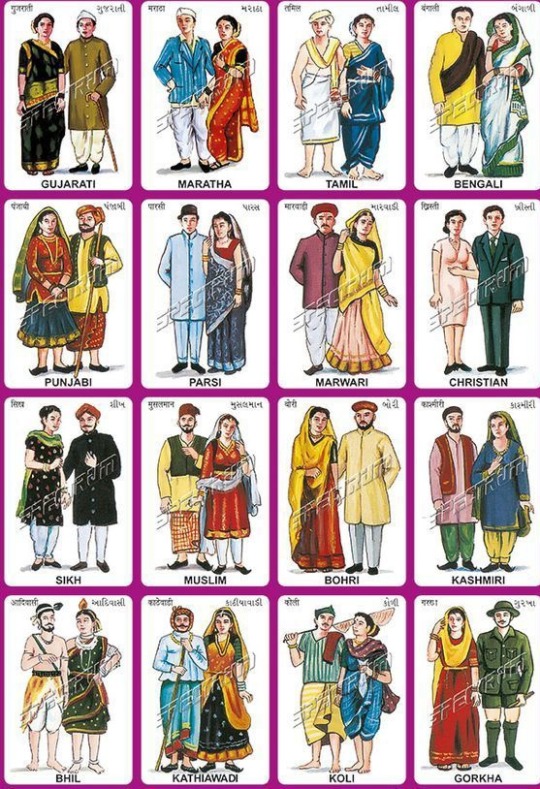
Indian dress culture is a rich and diverse tapestry of traditional clothing styles and designs that vary depending on the region, religion, and cultural heritage. Indian dress culture has a long history that dates back to ancient times, and it has evolved over the centuries, reflecting the influences of different rulers and invaders, as well as social, political, and economic changes.
Traditional Indian clothing is known for its vibrant colors, intricate designs, and rich fabrics. Some of the most popular traditional clothing styles include sarees, salwar kameez, lehenga choli, and kurta pajama. These garments are typically made from cotton, silk, or other natural fibers, and are often adorned with intricate embroidery, beadwork, and other decorative elements.
Sarees are long pieces of cloth that are draped around the body and are popular among women in India. They come in a wide variety of styles, designs, and colors and are often worn for special occasions and celebrations.
Salwar kameez is a traditional outfit worn by women in North India and Pakistan. It consists of a long tunic top called a kameez, and loose-fitting pants called salwar. The outfit is usually made from cotton, silk, or other lightweight fabrics and is worn for everyday wear as well as formal occasions.
Lehenga choli is a traditional outfit worn by women in North India, especially during weddings and festivals. It consists of a long skirt called a lehenga, a short blouse called a choli, and a dupatta (a long scarf) that is draped over the head.
Kurta pajama is a traditional outfit worn by men in India. It consists of a long tunic called a kurta, and loose-fitting pants called pajama. The outfit is usually made from cotton, silk, or other lightweight fabrics and is worn for everyday wear as well as formal occasions.
In addition to these traditional styles, Indian fashion has also been influenced by Western fashion trends, and many Indians now wear Western-style clothing as well. However, traditional clothing styles remain an important part of Indian culture and are still worn by many people, especially during festivals, weddings, and other special occasions.

HISTORY OF INDIAN CLOTHES:
The history of Indian clothes dates back to ancient times, and it has evolved over the centuries, reflecting the influences of different rulers, invaders, and social, political, and economic changes.
During the Indus Valley Civilization (2600 BCE-1900 BCE), people in India wore garments made of cotton and silk, and there is evidence of jewelry and accessories made of precious metals and stones.
The Mauryan Empire (322 BCE-185 BCE) is known for the development of the dhoti, a long rectangular piece of cloth worn by men that is wrapped around the waist and legs. The dhoti was also worn by women during this time, along with the saree, which was draped around the body and over the head.
The Mughal Empire (1526 CE-1857 CE) had a significant impact on Indian dress culture, introducing new styles and fabrics, such as the churidar, a form-fitting legging, and the anarkali, a long, flowing dress. The Mughals also brought with them the art of embroidery, which became an important part of Indian dress.
During the British colonial period (1858 CE-1947 CE), Indian dress culture was further influenced by Western fashion trends, with many Indians adopting Western-style clothing. However, traditional clothing styles remained popular, especially among the rural population.
After India gained independence in 1947, there was a renewed interest in traditional Indian dress, with designers and fashion houses exploring new styles and fabrics. Today, Indian dress culture is a vibrant mix of traditional and modern styles, with a wide variety of clothing styles and designs available for both men and women.


BUY NOW
MODERN VlOGGING( Click below the link)
CLICK HERE
5 notes
·
View notes
Text
Unveiling the Splendor of Ancient Indian Clothing and Style
India's rich history is adorned with a tapestry of clothing and fashion that has evolved over the centuries. From the Vedic times to the Indus Valley civilization, the clothing of ancient India tells a captivating story of tradition, culture, and artistry. In this blog post, we dive into the remarkable world of ancient Indian clothing, exploring the styles, fabrics, and colors that adorned both men and women. Let's embark on a journey back in time to discover the fascinating attire that shaped the fashion landscape of ancient India.

Clothing and Style for Men:
Dhoti: A cloth wrapped around the waist and knotted at the back.

Antariya: A white cotton or muslin cloth tied to the waist, accompanied by a sash called Kayabandh and a scarf called Uttariya.

Turban: A cloth wrapped around the head, often symbolizing social status and identity.
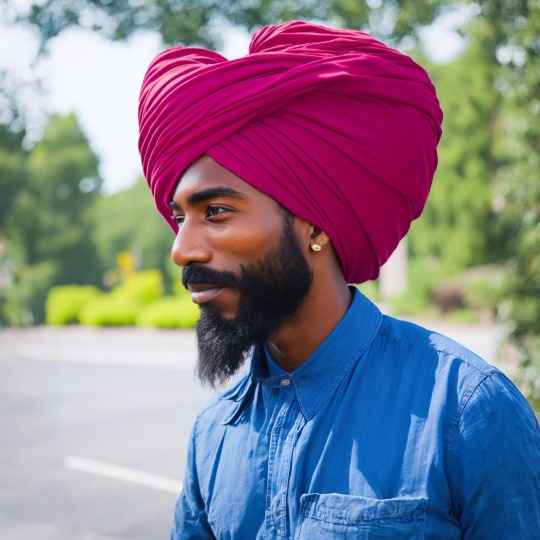
Phetas: Special turbans worn for religious purposes.
There are numerous types of phetas which are being used in different places across India for different purposes.
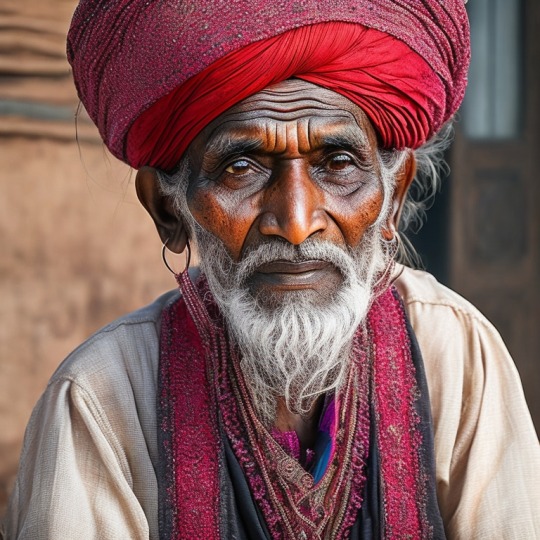
Peplon or chiton: Layered clothing made of linen and wool, adjusted according to weather conditions.

Man-buns and short or shaved beards were popular styles

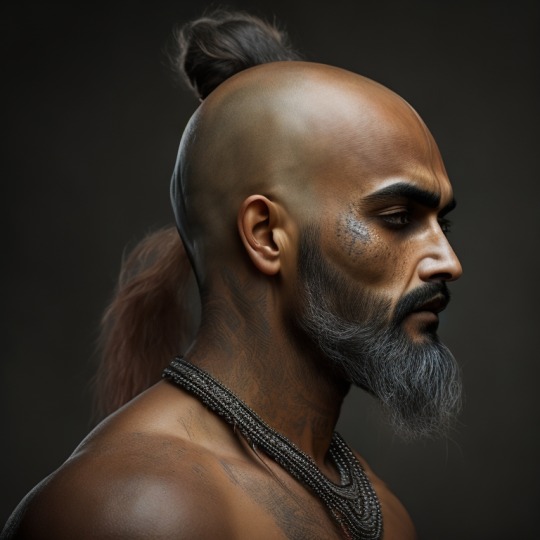
Clothing and Style for Women:
- Sari: A long piece of cloth draped around the body and over the head, showcasing elegance and grace
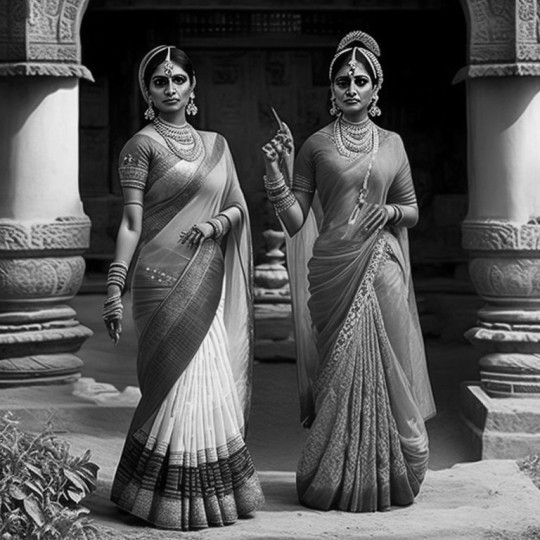
Knee-length skirts paired with intricate jewelry like bangles, earrings, and beaded necklaces.
- Elaborate jewelry made of stones, animal claws, feathers, and shells.
- Handloom textiles woven by skilled artisans.

- Gold ornaments, particularly worn by upper castes.
Sirradai: A short lower garment made of handspun cotton and silk.

Traditional Colors Used in Ancient Indian Clothing:
Ancient Indians were adept at dyeing clothes, and specific colors held symbolic significance:
- Ivory, jasmine, August moon, August clouds after the monsoon, and the color of the peacock's neck were significant traditional colors.
- The Vedic treatise Vishnudharmottara described these hues.
Traditional clothing of india
Men wore a variety of garments depending on their region, occupation, and social status. Some common examples include:
Lungi: A simple garment made of a single piece of cloth wrapped around the waist and legs, similar to a sarong.
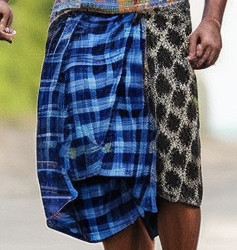
Veshti: A long piece of cloth wrapped around the waist and legs, similar to a dhoti but without the pleats.

Angrakha: A long tunic with a V-shaped neckline that is worn over a dhoti or other lower garment.
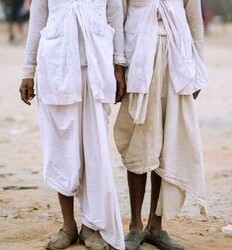
Sherwani: A long coat-like garment that was often worn for formal occasions.


Pajama: Loose-fitting pants that are typically worn with a kurta or other upper garment.
It's worth noting that the styles and materials of these garments varied widely depending on the time period and region in which they were worn.
Conclusion:
Ancient Indian clothing showcased the richness of culture, history, and artistry. Through the ages, men and women draped themselves in garments like dhotis, saris, turbans, and knee-length skirts, reflecting their customs, traditions, and social status. Warriors donned armor and wielded weapons as they protected their kingdoms. The vibrant colors derived from natural elements added splendor to the attire. The remnants of ancient Indian clothing, discovered through sculptures, paintings, and literature, provide us with a glimpse into the past, where clothing was not merely functional but also an expression of identity and heritage.
#beautyofindia #indianclothing #indianimpact #indianhertage#forgottenbharat
3 notes
·
View notes